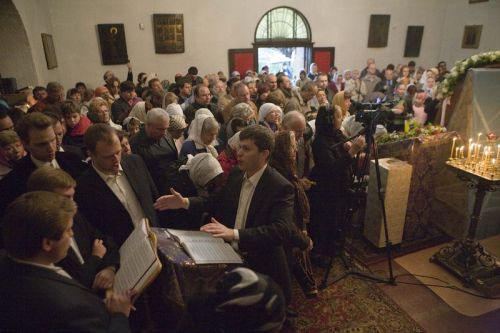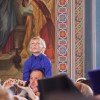Source: Crossroads: The Monthly Newsletter of the Orthodox Church of the Holy Cross
There is not a single liturgical service in the Orthodox Church which does not use chanting and singing extensively. Why is the Church’s worship expressed in song? The Orthodox Liturgy begins with the exclamation: “Blessed is the Kingdom of the Father, Son, Holy Spirit …” With these words we are invited to “come and see,” to enter into and experience the foretaste of a heavenly reality, the Kingdom of heaven on earth, which manifests itself in the Church’s liturgy. In this reality there is already expressed a transformation of our present world and of us who dwell in it. We are not simply inhabitants living in a particular spot on the planet, but we are “standing in the temple of Your glory, and we think that we are in heaven”. Not only is our life being transformed, but all aspects of the world participate in this transformation. A simple table becomes the throne of the Lord, bread and wine are transformed into the very life of Christ, and the syllables that make up our language of communication become words filled with the Holy Spirit. The words that are uttered from our lips are words of the Holy Spirit, words that are spoken of and by God. The Kingdom of God, experienced in the Liturgy, is thus an expression of the divine beauty: singing, hymnography, iconography, ritual, solemnity are all part of what is experienced by the faithful as the epiphany or manifestation of “heaven on earth.”
A good example of this manifestation of beauty as the expression and experience of the Kingdom of God can be found in the report of the emissaries of Prince Vladimir upon their return to Kiev after witnessing the Byzantine Liturgy at the cathedral of Hagia Sophia in Constantinople. In describing their experience of the Liturgy, they wrote: “The Byzantines led us to the edifice where they worship their God, and we knew not whether we were in heaven or on earth. For on earth there is no such splendor or beauty, and we are at a loss how to describe it. We only know that God dwells there among men”. What is most significant in this report is not just that the Russian emissaries witnessed a Byzantine worship service that they perceived to be “beautiful,” but that in this beauty they experienced the presence of God.
All worship in the Orthodox Church is regulated by the ordo, which not only establishes the structure of each service celebrated during the day, but determines both the prayers and hymns that are to be chanted and regulates, as well, the actions that accompany the prayer: e.g. censing, processions and entrances, light and darkness, standing, sitting, kneeling, and prostrating. Church singing is also regulated: regulated not only by the text which it serves, but by the liturgical function it accompanies. Thus, the selection of the music which we use in worship should be based upon liturgical considerations and nurture appropriate attitudes of prayer. A structural analysis of our liturgical services would distinguish the following forms of prayer which call for the use of song: dialogue, psalmody, and hymnography.

Dialogue: The Participation of All the People
A basic form of corporate Christian prayer is dialogue. Dialogue has occupied a central place in liturgical worship from the very beginning. Dialogue is basic to Christian prayer. In fact, the whole relationship of god with his people, from the time of the creation of man to the preaching of John the Baptist, and the life, death, and resurrection of Christ to the present day and hour can be described as a great dialogue between God and man. This dialogue has been initiated by God and one of the ways we respond to Him is in liturgical prayer — prayer in the form of thanksgiving, praise, and supplication.
An example of dialogue in liturgical prayer is the litany. The word litany come from the Greek word lite which means intercession. In the liturgical services, there are a number of litanies: the Great Litany or Litany of Peace, the Augmented Litany, the Litany of Fervent Supplication, the Evening Litany and the Morning Litany, all of which include invocations or petitions by the celebrant and a response by the people, i.e. a dialogue. In the Great Litany, the celebrant addresses the faithful and establishes an acceptable order of prayer. First he asks “let us pray to the Lord in peace,” the peace that is only possible because of the mediation of Christ, for it is in Him and through Him that we are able to pray with the certitude that our prayers will be heard and answered. The celebrant continues: “let us pray for the salvation of our souls, for the peace of the whole world, for the union of all.” At the conclusion of each petition, the people respond, “Lord have mercy.” i.e., Lord, be gracious to us and receive our prayers. In the Augmented Litany the petitions are addressed to God Himself: “Have mercy on us, O God, according to Your great goodness, we pray to You, hear us and have mercy.” Here the petitions provide for specific requests for the immediate needs of the congregation and its individual members.
The Anaphora is another example of the dialogue form. The Eucharistic Offering begins with a dialogue between the celebrant and the people. After summoning the people to stand with attentiveness and with fear, the priest blesses the people with the words: “The grace of our Lord Jesus Christ, the love of God the Father, and the communion of the Holy Spirit be with all of you,” to which the people respond: “And with your spirit.” The priest continues: “Let us lift up our hearts,” and the people respond: “We lift them up unto the Lord.” “Let us give thanks unto the Lord,” exclaims the celebrant, and the people give their agreement: “It is meet and right…”
The celebrant, presiding over the gathered community, then offers to God the prayer of thanksgiving of the faithful. This prayer expresses our total gratitude to God for all that He has done for us in creating, saving, and glorifying the world and endowing us with the Kingdom which is to come. The faithful join with the angels who stand next to God, singing “Holy, Holy, Holy, Lord of Sabaoth. Heaven and earth are full of Your glory! Hosanna in the highest. Blessed is He that comes in the name of the Lord. Hosanna in the highest.” The singing of the angelic hymn is followed by the prayer of remembrance that includes the words of Jesus to his disciples, “Take, eat, this is my body… drink of it, all of you, this is my blood…” to which the faithful signify their acceptance and agreement with the “Amen.” Then the celebrant offers the eucharistic gifts of the bread and wine to God, “Your own of Your own…” and the prayer of offering concludes with the singing of “we praise You, we bless You, we give thanks to You, and we pray to You, O our God.”
What is most evident from the texts of the Litany and the Anaphora is that both call for a most elementary form of communal participation — the prayer of the whole gathering. “Let us lift up our hearts.” “We lift them up unto the Lord.” “In peace let us pray to the Lord.” “We praise Thee, we bless Thee, we give thanks to Thee… and we pray to Thee.” The main reason that we come together is to become one people in God and to make our common offering of thanksgiving to Him. As Paul Meyendorff has pointed out, the use of the first person plural is always used in liturgical prayer in order to emphasize that liturgical prayer is the prayer of the entire community. Indeed, this Greek word for worship — leiturgia — means a common or corporate action which everyone takes an active part.
Psalmody
While biblical and liturgical scholars debate just how significant and extensive was the use of psalmody in the earliest Christian gatherings, it is well-established that by the year 375, according to the testimony of St. Basil the Great, the chanting of psalms was prevalent throughout all the churches of the Christian East. St. Basil, in his answer to the criticism of the Neocaesarean clergy against the psalmody practiced by his monks at vigils, describes the two different methods of chanting Psalms that were used in his monastery. He writes:
they (the monks) divide themselves into two groups, and sing psalms in alternation with each other … and then they entrust the lead of the chant to one person, while the rest sing the response.
The first method mentioned by St. Basil is commonly referred to as alternating psalmody. Those present in the church are divided in two groups and sing psalms to each other, alternating psalm by psalm or verse by verse. The kathisma (a division or grouping of psalms) at our services today (“Blessed is the man,” for example) are often chanted in this manner.
Beginning with the fourth century, antiphonal psalmody began to gain popularity, first in Jerusalem, then spreading to all parts of the Eastern Empire. Distinguished from responsorial psalmody, the antiphonal form called for the division of the people into two choirs, each of which responded alternately with a short, common refrain to psalm verses chanted by one (or two) soloist chanters. These short refrains were either a selected psalm verse, an Alleluia, a short non-Scriptural phrase (such as “Glory to Thee, O Lord,” “Have mercy on us, O Lord, etc.) or an independent sacred strophic hymn called a troparion. At the conclusion of the psalm verses, the Little Doxology (“Glory to the Father…”) was chanted, followed by a terminating troparion.
An example is the antiphonal chanting at the Paschal service. The service begins with the clergy chanting the Paschal Troparion, “Christ is risen” three times. The people respond likewise. Then selected verses of Psalm 68 (“Let God arise …“) are chanted by the clergy, alternating with the singing of the Paschal Troparion by the people. At the conclusion of the Psalm verses, the clergy chant the “Glory to the Father…” followed by the singing of the first half of the Paschal Troparion. The second half is then sung by the people, thus concluding the antiphon. This antiphonal format is used at the beginning of the Divine Liturgy (in the Greek
tradition) and at liturgies on Feast-days of the Lord (in the Slavic tradition). Examples of troparia inserted between the psalm verses include: “Through the prayers of the Theotokos, O Savior, save us,” “O Son of God, (who rose from the dead), (who was born of the Virgin), (who was baptized in the Jordan), (who ascended in glory), save us who sing to Thee,” in addition to the troparion of the particular Feast on major feast days.
It is important that we understand the function that the antiphon serves in our liturgical worship. St. Germanus writes in his commentary on the Liturgy that “the antiphons of the Liturgy are the prophecies of the prophets, foretelling the coming of the Son of God”. The words of the Psalms were used many times by Christ Himself to foretell his suffering, death, and resurrection. The texts of the Psalms are understood in the light of Christ — they “point” to Christ. The insertion of newly-composed troparia, serving as refrains between the verses of a psalm, functions as the Church’s interpretation of the psalm, e.g., “Let God arise …” (Ps 68, v.1) points to the words of the Paschal Troparion, “Christ is risen from the dead …“
Clearly, in both form and function, the use of liturgical dialogue (Litany and the Anaphora as examples) and responsorial and antiphonal psalmody (Prokeimena, Communion Hymn, Antiphons) implies the active participation of the people. These forms not only add variety to the liturgical service but they stress the corporate nature of our church rites, and provide, even for the least learned and musically talented person, the possibility to join in this corporate action. All that is required is the desire of the mind and the arousal of the soul to join in with the rest of the faithful. In this context, then, singing is an indispensable part of Orthodox worship in which all the people present participate.
Call for the Restoration of Liturgical Singing
The question of “church singing with the participation of all the people” was one of the issues raised by the bishops of the Russian Church in 1905 when they were asked to submit reports in preparation for a Great Council of the Russian Church. In his report, Bishop Constantine of Samara writes:
We must restore singing to that state which it should and formerly did have. It is necessary to renew in the minds of the people the notion that congregational singing is the norm, and that choral singing is only a substitution for this.
Bishop Evlogii of Kholm, who from 1922 to 1946 was Metropolitan of Western Europe, writing in support of congregational singing, suggested that this be “gradually introduced, beginning with the litanies and short hymns and then eventually include all the hymns of the Liturgy and the All-Night Vigil.”
The restoration of congregational singing was not simply a desire to institute reform in order to comply with a canonical standard or a historical precedent, but it was seen as a measure which would assist in giving to liturgy the life, the joy, and the power which is inherent in its purpose, content, form, and message. This is what the Deanery Report of the Shenkursk Province (Archangel Diocese) emphasized:
Generally, one can no longer overlook the concern for lifting up the grandeur and majesty of the Church services to the necessary and rightfully sacred heights, so that each believing Christian could, in fact, find joy and consolation in the Church, and not feel bored and fatigued. Choral, or even better, congregational singing and comprehensible chanting will play an important role in developing this.
The question of congregational participation and the availability of suitable music are issues that are being raised in our churches today by both clergy and lay people. With a few isolated exceptions, however, every little thought and even less direction has been given to these issues. As mentioned above, some ninety years ago bishops in Russia raised, discussed, and even offered suggestions for the implementation of a program to restore congregational singing to the church singing. They viewed this a necessity in order to bring life and vitality to the liturgical worship at that time. And it is not surprising that today the Orthodox Church in Russia is again reviewing this issue.
In America today so many of our churches, including both the traditional, “well-established” parishes with strong ethnic ties and the newer, multi-cultural, “pan-Orthodox” missions, comprised of numbers of Orthodox with little or no ties to ethnic traditions, are striving to maintain a spiritual and good liturgical life. More and more the leaders of these parishes are recognizing that in order to do this, the music which is used in worship must be singable, liturgically appropriate, and aesthetically pleasing.
One of the great fears felt by many choir directors, composers, and serious singers of church music is that in our haste to solve these problems, and especially that of the participation of the faithful in liturgical singing, the use of greatly inferior music in Orthodox worship will be the ultimate result. An adequate approach cannot be reduced solely to the question of “participation” or to the question of “musical style”, but rather must be grounded in a true understanding of the purpose, content, and expression of the Liturgy itself — the manifestation of the beauty and joy of God’s Kingdom. This indeed represents a challenge, not only to our church composers, but to our translators and poets, our liturgists, our pastors, and to all those who sing.















